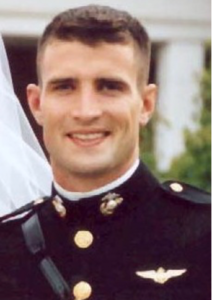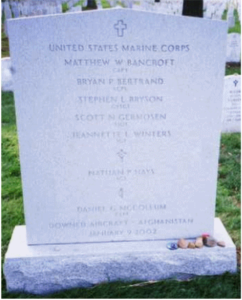Scroll of Honor – Daniel Gardner McCollum
The Global War on Terror
Written by: Kelly Durham
Most current Clemson students hadn’t been born, but those of a certain age will never  forget September 11, 2001. It was one of those days, like December 7, 1941 and November 22, 1963, that marked a generation and changed the way we look at our world. As the twentieth anniversary of that horrible day approaches, it is fitting that we remember Daniel Gardner McCollum, the first Clemson alumnus to fall in the Global War on Terror.
forget September 11, 2001. It was one of those days, like December 7, 1941 and November 22, 1963, that marked a generation and changed the way we look at our world. As the twentieth anniversary of that horrible day approaches, it is fitting that we remember Daniel Gardner McCollum, the first Clemson alumnus to fall in the Global War on Terror.
McCollum came to Clemson from Irmo and majored in mechanical engineering. He joined the Marine Corps Platoon Leaders Course in 1993 while he was still a student. According to friends, Dan McCollum dreamed from an early age of learning to fly. While at Clemson, he joined the Dixie Skydivers and could frequently be found at Oconee County Airport which sits on a plateau across the Seneca River from campus. Acquaintances, from friends to professors, described him as a nice guy, someone who was easy to get along with. Following his 1996 graduation and commissioning as a Marine Corps Second Lieutenant, McCollum attended flight school.
By the summer of 2001, Captain McCollum was assigned to Marine Aerial Refueler Transport Squadron 352 based at the Marine Corps Air Station in Miramar, California. Following the September 11 attacks, McCollum’s squadron was deployed in support of Operation ENDURING FREEDOM, the United States’ official name for the War on Terror. ENDURING FREEDOM included airstrikes targeting Al Qaeda and the Taliban in Afghanistan.
On January 9, 2002, Captain McCollum was copiloting a resupply flight originating in Jacobabad a small city just above sea level some three hundred miles north of Karachi, Pakistan. The flight was bound for Shamsi Airfield, a desert runway not quite two hundred miles to the east. Stretching between Jacobabad and Shamsi was a mountain range rising up more than four thousand feet. To add to the challenge of this winter night’s flight, Shamsi airfield sits in a barren desert, nestled between two rocky ridges.
As McCollum’s KC-130R aerial refueling tanker approached Shamsi  from the west, its crew requested clearance to land on a runway normally used for departing flights. Air traffic control denied the request in order to reduce aircraft noise over the nearby town. McCollum’s aircraft had to circle to reposition itself for an approach to the inbound runway. It was now dark on a no moon night. The airfield was not equipped with radar or navigational aids and only expeditionary lights were in place to illuminate the runway.
from the west, its crew requested clearance to land on a runway normally used for departing flights. Air traffic control denied the request in order to reduce aircraft noise over the nearby town. McCollum’s aircraft had to circle to reposition itself for an approach to the inbound runway. It was now dark on a no moon night. The airfield was not equipped with radar or navigational aids and only expeditionary lights were in place to illuminate the runway.
Compounding the relatively primitive facilities at this airfield, just over a hundred miles south of the Afghan border, was the absence of any night vision equipment onboard the airplane. None of the Marine Corps KC-130s in the theater was equipped with night vision capabilities, flight planning software, or global positioning systems. As the flight crew attempted to line up their aircraft for its approach, they were flying in combat conditions utilizing their onboard flight instruments.
Due to the airfield’s precarious position between the two ridges, aircraft on approach to Shamsi must maintain an altitude of seven thousand feet for maneuvering and five thousand, six hundred feet from which to commence final landing approach. Witnesses said McCollum’s plane circled twice in attempting to land. The aircraft then crashed into the side of a ridge and exploded. McCollum and the six other members of the tanker’s crew were killed in the crash.
Post-crash investigations revealed that the KC-130 hit the ridge at three thousand, eight hundred feet, well below the minimum safe altitude. Investigators opined that just two hundred more feet of altitude would have enabled the plane to clear the mountain and continue its approach. In response to the tragedy, the Marines began retrofitting KC-130s with night vision landing equipment.
The reputations of the crew members, “all seven of them,” said squadron commander  Lieutenant Colonel Carl Parker, “were stellar.” “All of our service members have made great sacrifices to take the fight to the enemy a long way from America’s shores.” Parker’s comments are a reminder that the freedoms and security we take for granted are purchased only by sacrifice, not just by service members, but by their families.
Lieutenant Colonel Carl Parker, “were stellar.” “All of our service members have made great sacrifices to take the fight to the enemy a long way from America’s shores.” Parker’s comments are a reminder that the freedoms and security we take for granted are purchased only by sacrifice, not just by service members, but by their families.
McCollum’s wife, Clemson alumna Jennifer Harkey McCollum, was then six months pregnant. Their son, Daniel Gardner McCollum, Jr. was born in the summer of 2002.
McCollum’s remains were interred at Arlington National Cemetery along with those of his crewmates. There is also a memorial marker to him at Bush River Memorial Gardens in Columbia.
For additional information about Daniel Gardner McCollum see:
https://soh.alumni.clemson.edu/scroll/daniel-gardner-dan-mccollum/
For more information about Clemson University’s Scroll of Honor visit:
